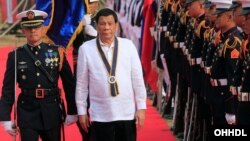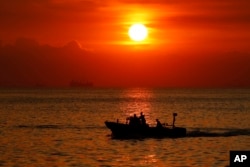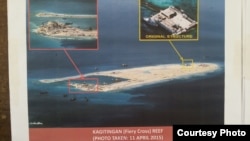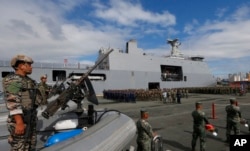A proposed upgrade to the Philippine navy, which lags behind its Asian peers, will help the country fend off Muslim rebels, foreign fishing boats and ships from China, experts in the region say.
Philippine President Rodrigo Duterte said May 22 the government was working on a second phase of modernizing the armed forces with a focus on the navy. This phase includes 77 billion pesos ($1.46 billion) in improvements for the 120-year-old navy, the presidential office website says.
“We live in exciting times for our armed forces as we further enhance the capability of our Navy,” Duterte said via his website.
The completion of this phase and possibly one more should make a difference, said Jay Batongbacal, a University of the Philippines international maritime affairs professor.
“If they follow their program, then it will provide enough capability on the part of the navy to carry out its function of surveillance, of patrolling against transnational and nontraditional threats to security,” he said. “They can do that.”
Threats from offshore
Coast guard officials from the archipelago of about 7,100 islands have said fishing vessels from China, Taiwan and Vietnam periodically pass through the Philippine exclusive ocean economic zone that extends 370 kilometers off its coast. All three foreign territories have overlapping maritime claims with the Philippines, particularly in the resource-rich South China Sea.
Coast guard vessels sometimes lack the manpower to stop foreign boats, a commander in Masinloc city on the South China Sea coast said last year.
The Chinese navy and coast guard sometimes come uncomfortably close to Philippine-held islets in the sea’s Spratly Islands, as well.
On May 11, both Chinese agencies “challenged and harassed” the Philippine navy near Ayungin Shoal, 194 kilometers offshore, lawmaker Gary Alejano said in a media statement Wednesday.
Beijing and Manila dispute the Spratlys, where China has militarized three reefs. The two countries argued openly from 2012 to 2016, before Duterte took office and sought peace. Last year a Chinese vessel reportedly planted its national flag on a cay in the Philippine-controlled part of the Spratly chain.
The Philippines will keep trying to avoid upsets with China, said Alan Chong, associate professor at the S. Rajaratnam School of International Studies in Singapore. Beijing gives Manila aid and investment for infrastructure renewal. China would still have more firepower even after the Philippine navy modernizes, he added.
“Even if tomorrow the United States sells the Philippine navy its latest destroyers, there’s no way the Philippines can fend off a determined Chinese for defense of the islands,” Chong said.
The Philippines prefers negotiations with China to any military movement, said Ramon Casiple, executive director of Philippine advocacy organization Institute for Political and Electoral Reform.
Manila faces threats from the south, too. Lack of patrols in the 285,000 square-kilometer Celebes Sea lets “terrorists” enter the country, the Jamestown Foundation security research organization says.
The Philippine government suspects Islamic State-sympathizers from nearby Indonesia and Malaysia reached the country illegally last year to help local Muslim rebels fight a five-month war against government troops.
“Public support for (naval improvements) is very strong. And even in some sectors they think it should be made a priority,” Casiple said. “Certainly you cannot do without modernization.”
One such sector is the military itself, Batongbacal said.
New hardware
The naval upgrade, part of a program that began under Duterte’s predecessor Benigno Aquino in 2013, will add two American-made TC90 patrol aircraft, two “multipurpose assault craft” and a sealift vessel, the president’s website says. The Middle Eastern country of Jordan will give the Philippines two Cobra helicopters, as well.
The Philippine navy ranks No. 20 in the world based on the numbers of vessels, online database GlobalFirePower.com says. China, Indonesia, Japan and the two Koreas rank higher than the Philippines in East Asia. Vietnam and Taiwan place higher in overall military strength.
“The Filipino navy, even a modernization project would begin with a low point,” said Alexander Huang, strategic studies professor at Tamkang University in Taiwan.
“I would not treat it as a fake news,” he said. “I think they do have an intention to beef up their maritime defense capacity, but it really depends on how much resources, especially financial capability (they have) to back up their verbal claims.”
Manila will continue working with “allies and friends” such as the United States on larger, more “strategic” naval missions, Batongbacal said. The modernization, he said, does not propose to cancel that cooperation.
Manila and Washington do joint naval drills every year, with Australia and Japan joining the event in May 2018.











